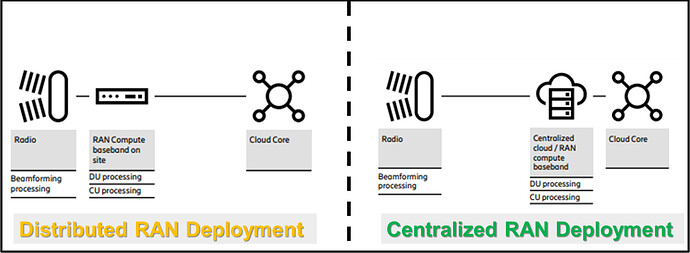-
My friend: Hi Ibrahim, I need your help.
- Me: You’re welcome, please tell me.
-
My friend: My manager asked me to prepare an initial design for one 5G Open RAN network with some rough estimations about the usage of D-RAN and C-RAN and I don’t know how can I do that, could you please support here?
- Me: Actually, the usage of either D-RAN (Distributed RAN) where the RU and baseband unit are located at the cell site and C-RAN (Centralized RAN) where the RU is located at the cell site while the baseband is centralized at any data center, depends on the use case you want to achieve. So, for example if you want to realize URLLC use case at any site, then normally you would go for D-RAN as you can locate the DU and CU-UP at the cell site to achieve lower latency, while for other use cases you could go for C-RAN.
-
My friend: But what is the benefit of C-RAN?
- Me: C-RAN has many advantages as simply all resources for multiple sites are located in one location as a pool, so when there is a traffic spike at any site, resources can be taken from this pool to serve this traffic spike, and this will improve RAN resiliency greatly. Also, cell sites will be simplified as it should contain only the RUs which will reduce the energy consumption and the cooling requirements. And you can imagine an improved RAN performance as processing traffic from multiple sites within the same location helps in inter-site coordination functions such as inter-site carrier aggregation and coordinated multi-point (CoMP) features. By the way, it is highly recommended that centralized RAN is virtualized as centralization has been promoted as a requirement for virtualization from the very beginning and so C-RAN is referred to as Cloud-RAN as well where software is disaggregated from hardware.
-
My friend: I think C-RAN is having many advantages than D-RAN, so why not to go for C-RAN at the whole network and get rid of D-RAN?
- Me: Any network should be a mix of both C-RAN and D-RAN to allow for flexibility in deploying any 5G use case you want. Also, take care that C-RAN is putting high requirement on the fronthaul capacity which will be carried over fiber cables and MNOs should have a high capacity for the fronthaul, otherwise C-RAN can’t be implemented and then we should go for D-RAN if the MNO has not enough fronthaul capacity.
-
My friend: Thank you so much. You made it very clear.
- Me: You are most welcome.
LinkedIn: Ibrahim Sayed, PMP on LinkedIn: #5g #5gnr #5gtechnology #openran #oran | 16 comments
